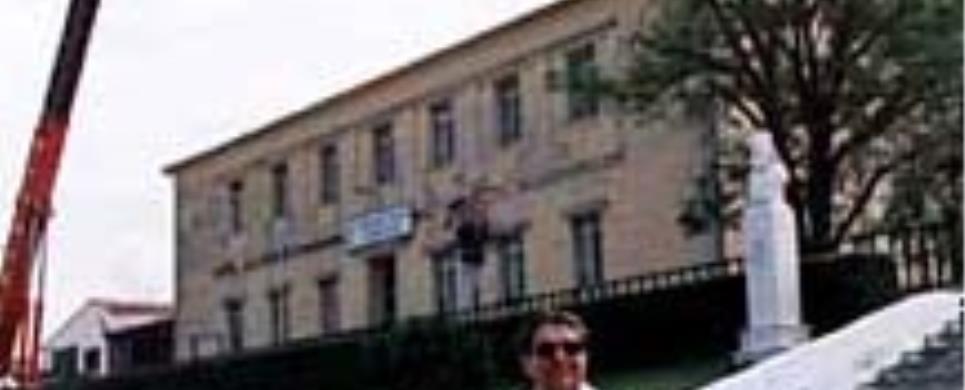Listed 16 sub titles with search on: Local governments for wider area of: "DIDYMOTICHO Municipality EVROS" .
ASSIMENIO (Village) DIDYMOTICHO
Tel: +30 25530 41361
ASVESTADES (Village) DIDYMOTICHO
Tel: +30 25530 93367
DIDYMOTICHO (Town) EVROS
Didymoteichon, today a small town of approximately 12000 people, bears
a long and extremely noteworthy history.
The city is lying next to the Erythropotamos
river, on the western bank of the famous Hevros
river.
The first habitation was founded on the Hagia Petra hill at the Southeastern
end of the city in the Neolithic period, according to recent excavational evidence.
During the Early Iron Age two villages existed together in both hills of the city,
Hagia Petra and Kales, the second lying at the western end of today’s Didymoteichon.
Abundant quantities of ceramics (local, imported Attic & Thasian pottery
etc.) as well as other findings form the ancient historic times witness not only
the existence of a city at that period but, even more, its close relations with
the Greeks.
During the "Pax Romana" the emperor Traianos re-established
the city, honouring it with the name of his wife, Plotina. Plotinopolis became
one of the most important cities of Roman Thrace,
being itself under an autonomous regime. The city reached a remarkable status
of welfare, reflected on random findings or results of the few excavational works
done up to now: floor mosaics representing the Hercules deeds and the Zeus-Swan
and Leda legend, or the famous golden head of the emperor Septimus Severus. The
decadence of the Empire & the barbaric invasions & lootings caused the gradual
transportation of the city from the hill of Hagia Petra to that of Kales. It's
perhaps then that Didymoteichon took its last name, if we accept that it means
Twin (= δίδυμο) castles. During the Byzantine period the importance of the city
is growing, because of its crucial geostragetic position and its steep, impregnable
stronghold of Kales where it lied. This constantly growing significance is well
marked by writers of the Middle and Late Byzantine times Greeks as well as foreigners,
like Godfried Villeharduin, who stresses that "Ditymoteichon was the strongest
and one of the richest cities of Romania" (= the territory of the Byzantine
empire). Especially during the Paleologian period (13th and first half of the
14th century) Didymoteichon becomes the focus of the historical events: capital
of the emperors Andronicos the Third the Paleologos and Ioannis the Sixth Kantakouzenos
during the catastrophic civil wars of 1321 to 1354, also witnesses the birth of
"Purple-born" emperors, as well as royal weddings, imperial army, inauguration
of two emperors, etc. Unfortunately only recently excavations have began to bear
in light the expected traces of this glorious past:
An imperial foundation nest to Agios Athanassios post-byzantine church
where the excavation has revealed a peculiar structure and some unique fragments
of byzantine frescoes, the humble funeral chapel of Hagia Aikaterini, the hundreds
of rock-cut caves, shaped by the mediaeval inhabitants of the city as cisterns
or storerooms at the back of their houses and of course the byzantine walls retaining
building phases form Justinian time to the early Ottoman period on the surfaces
of the towers and in the castle one can still can see monograms of byzantine nobles,
imperial families etc.
The Turkish occupation holds for more than 550 years, from 1361 to
1920 and is characterized from an extraordinary early ottoman building activity,
parallel to the choice of the city as a temporary capital of the empire.
On the other hand the greek element has a thriving presence and through
the years becomes the dominating factor socially, economically & culturally as
is shown by the vast quantities of the exported Didymoteichon pottery and the
post byzantine churches with the marvelous wooden temples and icons, offered by
the powerful professional unions.
The city was liberated in 1920, 19th of May.
This text (extract) is cited September 2003 from the Municipality
of Didymoteichon tourist pamphlet (1995).
ELLINOCHORI (Small town) DIDYMOTICHO
Tel: +30 25530 23460
ISSAAKIO (Village) DIDYMOTICHO
Tel: +30 25530 23582
KAROTI (Small town) DIDYMOTICHO
Tel: +30 25530 91280
KOUFOVOUNO (Small town) DIDYMOTICHO
Tel: +30 25530 24484
KYANI (Village) DIDYMOTICHO
Tel: +30 25530 93280
MANI (Small town) DIDYMOTICHO
Tel: +30 25530 91272
PETRADES (Village) DIDYMOTICHO
Tel: +30 25530 92220
PIMENIKO (Village) DIDYMOTICHO
Tel: +30 25530 95229
PITHIO (Small town) DIDYMOTICHO
Tel: +30 25530 41205
PRANGIO (Village) DIDYMOTICHO
Tel: +30 25530 92002
SITOCHORI (Village) DIDYMOTICHO
Tel: +30 25530 95227
SOFIKO (Small town) DIDYMOTICHO
Tel: +30 25530 31888

DIDYMOTICHO (Town) EVROS
Tel: +3025533 50602
Fax: +3025530 24424
Receive our daily Newsletter with all the latest updates on the Greek Travel industry.
Subscribe now!